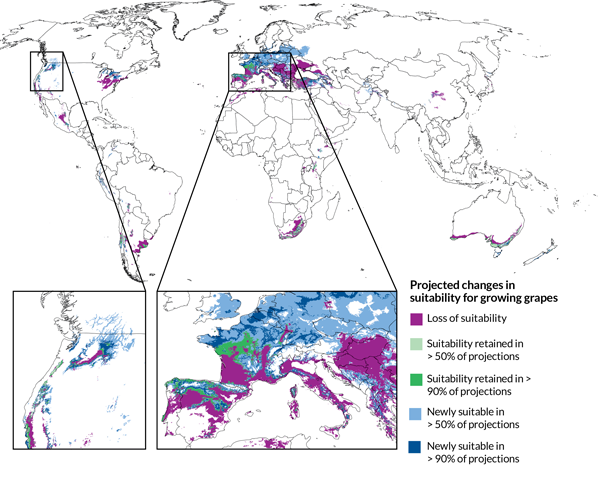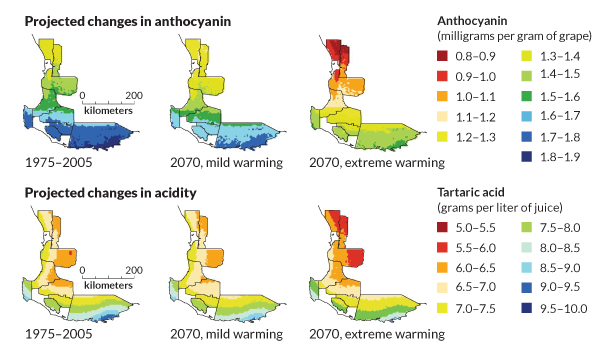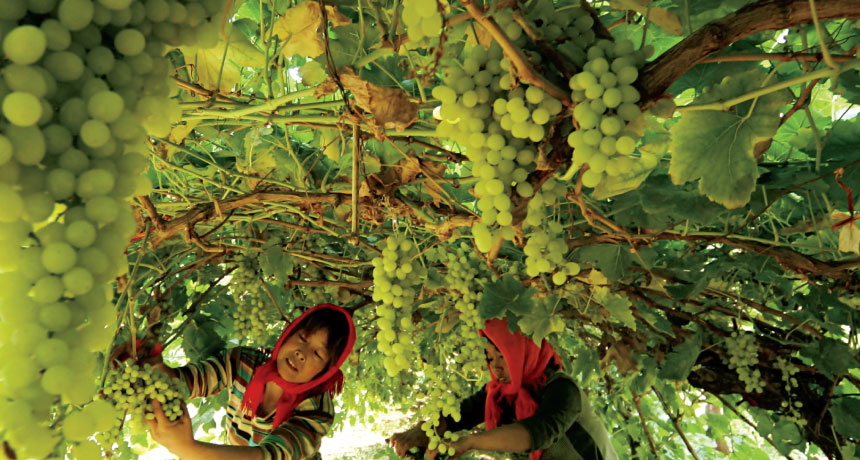
GRAPE EXPECTATIONS As famed regions such as Napa and Bordeaux become too warm, wine producers will have to find new places to grow grapes, such as in China’s Xinjiang region (shown).
STR/AFP/Getty Images
Antonio Busalacchi knows quality wine. As a sommelier, his educated palate can discern the oak undertones or mineral accents of a wine — flavors that elude most wine drinkers. He picks up on other nuances too. One sip of deep, inky purple, and he can distinguish the jammy, syrup-ripe fruit flavor of a shiraz grown in a warm climate from the lean olive notes of a syrah, made from the same grape, grown in a cooler region of France.
In his day job, Busalacchi offers another take on his favorite wines. A climatologist at the University of Maryland, he recognizes that he soon may be praising the merits of a fine English — not French —sparkling wine, or discussing the complexity of a world-class Tasmanian cabernet sauvignon.
The reason: climate change. Warming temperatures are already affecting vineyards from France to Chile. So far, rising temperatures have been mostly good for wine. Warmer, longer growing seasons have allowed grapes to stay on the vine longer, producing fruit that results in stronger, bolder wines with higher alcohol content.
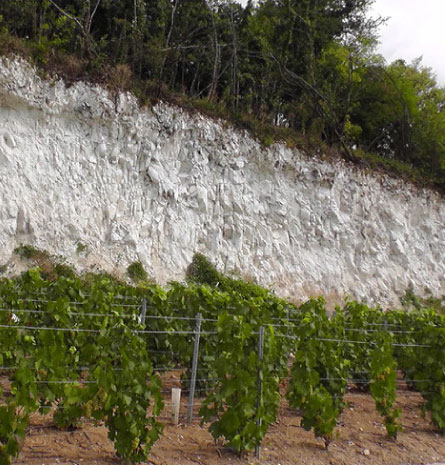
But as the world continues to warm, conditions in some areas will sour. Signature wines produced in some of the world’s most famous regions, such as Champagne or Bordeaux, will probably lose some of their quality and character. And the projected temperature changes will make it increasingly difficult for these renowned regions to grow their famed grapes at all, Busalacchi says.
His prognostications have scientific backing. A 2005 study in Climatic Change led by climatologist Gregory Jones of Southern Oregon University found that the average growing-season temperature in 27 prime wine-producing regions had risen in the previous 50 years. Seventeen of the regions showed an average temperature climb of 1.26 degrees Celsius. In the vineyards of Spain, Portugal, southern France and Italy, average temperatures rose even more. By 2049, average temperatures in most wine regions will shoot up another 2 degrees, Jones projected.
According to these projections, by midcentury Bordeaux could reach the upper temperature limits for growing red varieties, and will fall outside the ideal climate for its white grapes. Other areas are threatened too. Last year an international team of scientists showed that by 2050, some of the world’s most famous wine-making regions, including Tuscany in Italy, will shrink by nearly 70 percent.
That doesn’t mean the end of sauvignon blanc or merlot. But in the not-so-distant future, these well-recognized French wines may not come from France. Some wine producers in Champagne or Bordeaux already are moving north and setting up vineyards in southern England. There the soil is similar to the chalky substrate of Champagne, offering a hospitable environment for growing quality grapes. In other parts of the world, growers are expanding into areas previously not known for wine, setting up vineyards in India, Brazil and China.
These geographic shifts will keep the wine flowing, but may bring new pressures on wildlife and other natural resources such as water, says climatologist Lee Hannah of Conservation International’s Moore Center for Ecosystem Science and Economics. When Hannah and his team looked at the conservation implications of the wine industry’s geographic overhaul, they were “stunned,” he says, by the magnitude of changes that could come over the next few decades.
Their study, published last April in the Proceedings of the National Academy of Sciences, showed that some of the best places to grow wine grapes in 2050 will overlap with panda habitat in China, as well as regions north of Yellowstone National Park where land is being set aside for bears, antelope, mountain lions and other species.
The potential conflicts are a sign of what’s to come. Although wine grapes may seem like a frivolous crop to some, they represent big business: Analysts estimate that U.S. consumers spent over $30 billion on wine in 2012. What’s more, scientists say the plant’s extraordinary sensitivity to temperature makes the industry a strong early-warning system for problems that all food crops are expected to confront as climates continue to change.
Because wine grapes are a particularly good bellwether for other crops, similar issues may soon arise for producers of coffee, chocolate, hops and a host of other products, Jones says. “The narrow range in which the crop is most successful from a production and quality standpoint can change quickly in today’s climate shifts.”
Nature of terroir
Even with changes afoot to keep wine production and quality consistent as climate changes, wine lovers may detect some differences in their vino. Because the local geology and landscape play a vital role in shaping a wine’s taste, transporting grapes to new regions could result in different flavors.
“One of the unique attributes of the Champagne region in France is the chalky soil,” Busalacchi says. “That limestone soil is an important attribute, giving wine grapes the drainage and acid backbone needed to produce dazzling champagne wines.”
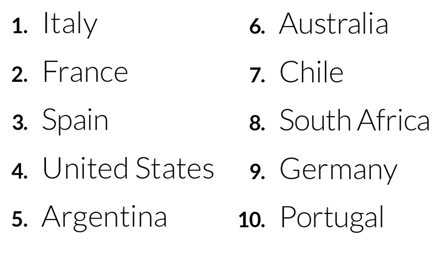
In fact, those local differences have conspired to turn a single species of grape, Vitis vinifera, into the source of the vast array of premium wines popular today. Most of the world’s wine production comes from just a few vinifera varieties, including chardonnay, sauvignon blanc, cabernet sauvignon, merlot, pinot noir and Johannisberg riesling. These grapes are extremely responsive to their physical environment. Soil composition, moisture, hours of exposure to sunlight — even the way that the leaves drape over the fruit — all affect the overall quality and taste of the final product, wine. Such factors get at the nature of terroir, a word that ascribes a wine’s uniqueness to the physical environment where grapes grow.
Creating the ideal conditions for growing quality wine grapes is, as Jones puts it, a multibillion dollar issue. Though there’s not one perfect environment for grapes, there is a well-known range of characteristics that growers look for. Grapevines hate wet feet and do best in arid areas where temperatures don’t dip below 12˚ or 13˚ Celsius during the growing season, or spike above 22˚ C. Sunlight is important too. As a vine’s leaves soak up sunshine, the light fuels photosynthesis, which fills the grapes with sugars. After fermentation, these sugars become alcohol.
The combination of arid land, temperature and sunlight makes places such as California and southern Italy a paradise for growing wine grapes — at least for now.
The good problem
Of all the climate influences on grapes, temperature is the most influential. Jones says heat can enhance ripening, allowing grapes to develop sweeter, bolder flavors.
That’s why recent warming has been a boon for wine producers. Rising temperatures have allowed growers to keep the fruit on the vine longer — a strategy that would not have worked 30 or 50 years ago when fall frosts occurred earlier.
As the heat rises, so does the resulting wine’s alcohol content. A warmer growing season or longer hang time on the vine produces more sugar in the grapes. Later, during fermentation, the sugars are converted by yeast into alcohol. So the greater the grapes’ sugar concentration, the higher the wine’s potential alcohol level. For example, the cool conditions of the Champagne region produce low-sugar, high-acid grapes that are well suited for champagne, which is about 13 percent alcohol by volume. Wines from warmer regions — say, a shiraz from Australia’s Barossa Valley or a zinfandel from California’s Central Valley — often have up to 15.5 percent alcohol by volume.
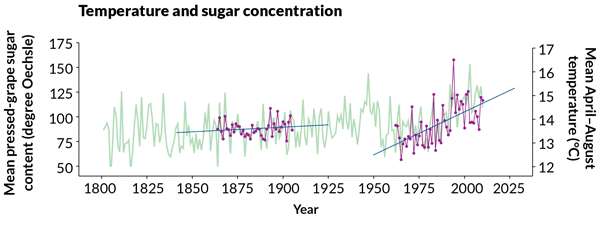
Wine growers have already started to see sweeter grapes and higher alcohol levels. In Germany’s Franconia region, the sugar content of pressed grape juice that’s used to make wine rose some 20 grams per liter each decade from 1962 to 2010, researchers reported July 23 in PLOS ONE. The team concluded that changes in growing-season temperature account for more than 40 percent of the increase.
Elsewhere, research has shown that potential alcohol levels of riesling at harvest in Alsace, France, have increased by 2.5 percent over the last 30 years. For Napa wines, average alcohol levels rose from 12.5 to 14.8 percent from 1971 to 2001.
“Some may argue that this trend is driven by economics, catering to consumers’ taste for bigger, bolder wines,” Jones says. “But our research shows that climate variability and change has clearly helped boost the alcohol levels.”
Busalacchi agrees, noting that the warming trend to date has also helped wine production flourish. Higher temperatures have opened, or reopened, wine regions in places such as southern England. Thirty years ago, growers there could produce only a few, lesser varieties of grapes. Today, growers in Sussex, Surrey and Kent are growing a number of premier varietals, including chardonnay and pinot noir.
“A number of wine regions around the world are in the sweet spot right now,” Busalacchi says. “We have been seeing places like Bordeaux, Germany and northern Italy, even California, putting together a string of very good and very consistent vintages as a result of climate.”
In some areas of France, Busalacchi says, wine producers refer to climate change as le bon problème, or the good problem.
Tipping a delicate balance
That may change as temperatures continue to rise. In a warmer than ideal environment, grapes may ripen too rapidly, altering the all-important balance of sugar, acid and potential alcohol content.
“Acid is a very important component of the wine,” Busalacchi says. “It’s that acid together with the tannins in the wine that cut through the fats in a steak or other foods and gives you that mouth-cleansing effect that helps boost your appetite.”
If temperature shoots too high, the heat can shut down photosynthesis altogether. Because photosynthesis helps activate the genes needed to develop color and flavor compounds in the fruit, a shutdown will wash out the grapes’ color and alter the acid and sugar content, resulting in the loss of some flavor and aroma.
These changes will be especially noticeable in high-quality wines that generally get “better” with age, Busalacchi says. Such wines are usually made with premium grapes of a specific type to produce a consistent taste, whereas everyday table wines are often blended from grapes of different regions.
That’s why some famed regions are in danger of extinction. Before the end of the century, for instance, Western Australia may no longer be known for its cabernet sauvignon or shiraz. Using climate simulations, Australian researchers found that by 2070, the acidity and concentration of a compound that gives red wine its color could dip below thresholds needed to maintain high-quality wine. The team reported the bad news in September in the International Journal of Biometeorology.
Warming will bring other headaches too. The changing climate will enhance the wide variations in weather that mid-latitude regions already experience from year to year and bring an increased number of extreme events such as heat waves and hailstorms, Busalacchi says. Heat waves can shut down photosynthesis, and hailstorms can damage grapes, ruining a season’s production in minutes. This past growing season, a tremendous hailstorm hit widespread parts of France. The storm devastated harvests in Bordeaux, Champagne and other regions.
“By next year, it could be back to normal,” Busalacchi says. “However, that is illustrative of what we expect more of in the future.”
Changes in temperature and humidity may also leave grapes more susceptible to fungal diseases or other microbial invaders.
And, by changing the grapes’ resident microbes, such shifts may more directly alter wine. In a study led by scientists at the University of California, Davis, researchers collected 273 samples of pressed grapes from California wineries in Napa, Sonoma and San Joaquin counties as well as from along the Central Coast. The researchers analyzed DNA fragments in the samples to show that the microbial populations varied from region to region, even on the same variety of grape. The findings, published in the Jan. 7 Proceedings of the National Academy of Sciences, showed that factors such as heat and humidity had an important influence on the type of microbes that colonize a grape’s surface.
Microbiologist David Mills, who directed the study, says that ultimately, these microbes help in the fermentation process, but they can also affect the wine’s taste. Weather-related events are probably driving some of the year-to-year changes in the grapes’ microbial communities seen in the study, Mills says. Though the team did not set out to look at climate change, “I would argue that climate change itself is going to have an impact” on the quality of wine grapes, he says. Exactly what that impact might be is still unclear.
Toasting the future
Some vineyard managers are finding ways to adapt to the warmer climate. In many areas producers are making modifications to trellises or to grapevines themselves to deflect rising temperatures. For example, by changing the vine’s orientation so that it faces a more northerly direction, managers can limit direct exposure to the sun and keep grapes cooler as temperatures rise.
Some vineyards that are already in relatively cool places will be less affected by climate change. Vineyards planted at higher altitudes or near the ocean — such as those in Oregon and Washington and in Argentina’s Mendoza Province — will be less affected by rising temperatures and may continue to benefit from the warming trend. Still, even growers in these areas will likely have to swap in new varietals to keep up with climbing temperatures, Jones says.
In the laboratory, scientists are experimenting with genetically modified grape varietals to help growers find more high-tech ways to adapt. At the University of Florida, biotechnology researcher Dennis Gray is developing methods to genetically alter premium grape varieties to make them more disease resistant.
It’s not an easy task. Although scientists have developed fungus-resistant varieties using traditional plant-breeding techniques, cross-breeding compromises the quality of the grape. “If you make a cross using traditional breeding techniques, you don’t get anything that resembles the original parent grape in terms of flavor or taste,” Gray says.
To get around this obstacle, he uses precision breeding: Instead of mixing entire sets of the DNA from two parents, he selects the gene needed for a specific trait such as resistance to a disease and inserts it into a recipient grape. By transferring only the genes necessary for disease resistance, Gray says the technique may leave the vine’s other traits intact.
Whether this strategy can boost disease resistance in grapes is not known. Even if proven successful, the genetically modified varieties may not be accepted by producers. In many European countries, including France and Italy, wine production is governed by strict appellation systems that tie specific wines to their geographic locations. This practice, which dates back hundreds of years, dictates the grape varieties that producers can grow and is meant to preserve a wine’s characteristics, which are influenced by a region’s special growing conditions. In many regions, appellation rules also govern wine-making practices, such as whether or not growers can irrigate or add ingredients to adjust alcohol or acid levels in the final product.
As climate change unfolds, local appellation laws may have to change to permit irrigation or to allow for grape varietals that can tolerate warmer climates, scientists say.
“The Romans said, ‘in wine there is truth,’ ” Jones says. “The truth now is that the Earth’s climate is changing much faster than the wine business, and it is advantageous for the wine industry to be proactive in assessing the impacts.”
